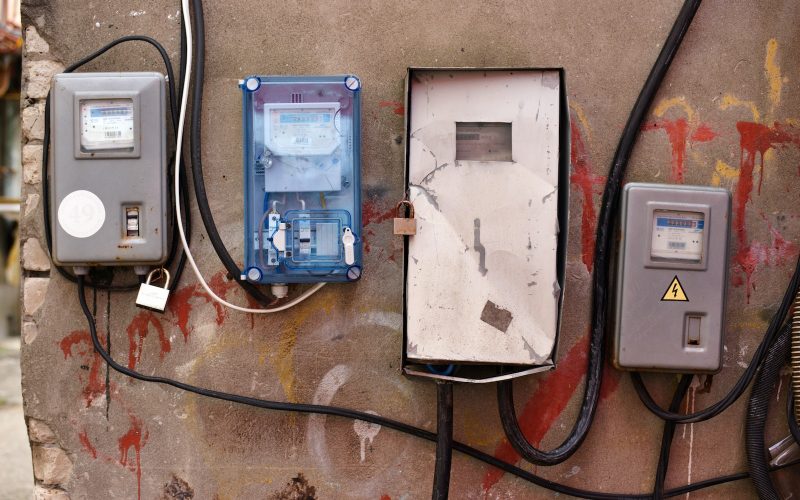When it comes to electrical installations, safety is paramount. The electrical box is one of the most critical components of any electrical system.
Electrical boxes provide a secure and safe environment for the wiring and connections of an electrical system.
But with so many electrical boxes available, knowing which is best for your project cannot be easy.
In this post, we’ll discuss the various types of electrical boxes and their uses so you can make an informed decision about your next electrical project.
1. Round Pan Electrical Box
Round pan electrical boxes are circular and are commonly used for ceiling fixtures such as chandeliers, pendant lights, and smoke detectors.
They have a flat back and a raised rim around the front edge, which provides support for the device attached to it and also prevents the device from falling into the hole.
These different types of electrical boxes are available in metal and plastic materials, with metal boxes being the more durable option.
They come in various sizes and depths, so it’s essential to choose the appropriate box based on the size and weight of the fixture.
To install a round pan electrical box, you’ll need to turn off the power to the circuit.
Then, you can trace the box’s outline onto the ceiling, cut the hole using a drywall saw, and insert the tube.
Use screws to secure the box to the ceiling joists, then attach the fixture. In summary, round pan electrical boxes are essential for safely mounting ceiling fixtures and ensuring they are secure.
Choose the appropriate size and material based on the weight and size of your institution for a safe and sturdy installation.
2. Metal and Plastic Electrical Box
Metal and plastic electrical boxes are the most common types of boxes used in residential and commercial construction projects.
Metal boxes are generally made from steel or aluminum, while plastic boxes are made from PVC or ABS materials.
Both boxes have advantages and disadvantages; the choice depends on the specific application and local electrical codes.
Metal boxes are generally more robust and durable than plastic boxes, making them ideal for use in high-traffic areas or areas with a high risk of damage.
They are also more fire-resistant than plastic boxes, a crucial safety feature.
However, metal boxes are more difficult to install than plastic boxes, as they require cutting through metal studs or other structural elements.
Plastic boxes, on the other hand, are lighter and easier to install than metal boxes, making them ideal for use in walls and ceilings where weight is a concern.
They are also more affordable than metal boxes and do not rust or corrode over time.
However, plastic containers are not as strong or durable as metal boxes, which can be a concern in specific applications.
The choice between metal and plastic electrical boxes depends on the project’s specific needs.
It is essential to consult with a licensed electrician to ensure that the chosen boxes meet local electrical codes and provide the necessary safety and functionality.
3. Electrical Box Covers
An electrical box cover is an essential accessory for electrical boxes that helps to protect and secure electrical wiring connections.
These covers are available in different materials, sizes, and designs, and their primary function is to cover the opening of an electrical box, protecting it from dirt, dust, and other harmful elements.
The most common types of electrical box covers are flat, typically made of metal or plastic, and screwed onto the box.
Some cover snap into place, like dome-shaped ones used for round electrical boxes.
Weatherproof covers are available for outdoor applications and feature a gasket that seals out moisture and protects against corrosion.
They come in various sizes to accommodate different electrical box sizes and are often made of non-metallic materials.
When choosing an electrical box cover, it’s essential to consider the box’s size, its type of material, and its intended use.
A qualified electrician can help you choose the right cover for your application.
In summary, electrical box covers are a necessary accessory that ensures your electrical system’s safety and proper functioning.
They offer protection against damage and, in some cases, weather resistance, making them an essential part of any electrical installation.
4. Octagon and Round Electrical Box
Octagon and round electrical boxes are often used for installing light fixtures and ceiling fans.
These boxes come in various sizes and depths to accommodate different types of institutions and wiring.
Octagon boxes, as the name suggests, are shaped like an eight-sided polygon.
They are typically used for installing ceiling lights and other fixtures attached to a ceiling or wall.
The boxes are available in different depths to accommodate the thickness of the drywall or plaster, as well as the size of the wiring.
Round boxes, on the other hand, are typically used for ceiling fan installations. They come in various depths and sizes to accommodate the weight and size of the fan.
Round boxes are often designed with braces or supports to provide additional strength and support for the fixture.
It is important to note that both octagon and round electrical boxes should be installed correctly, according to the manufacturer’s instructions and local electrical codes.
To safely hold the fixture’s weight, the containers should be securely fastened to structural support, such as a joist or stud.
5. Outdoor Electrical Box
Outdoor electrical boxes are designed for outdoor electrical installations, protecting against moisture, rain, snow, and other harsh weather conditions.
These boxes are made from durable materials, such as weather-resistant plastic or corrosion-resistant metal, to ensure long-lasting performance in outdoor environments.
Outdoor electrical boxes are commonly used for installing outdoor outlets, light fixtures, security cameras, and other electrical devices in patios, decks, gardens, or other outdoor spaces.
These different types of electrical boxes are equipped with gaskets or seals to prevent water or debris from entering the package and compromising the electrical connections inside.
When installing an outdoor electrical box, choosing one rated for outdoor use and suitable for the specific environment is essential.
The package should also be properly grounded and installed according to the local electrical codes and regulations.
Overall, outdoor electrical boxes are essential for providing safe and reliable power to outdoor areas.
They protect electrical connections from moisture and ensure the longevity and functionality of outdoor electrical installations.
When planning any outdoor electrical project, include the appropriate outdoor electrical box for a secure and efficient electrical system.
6. Standard Rectangular Box
Standard rectangular electrical boxes are the most commonly used electrical boxes. They are used to house switches, outlets, and other electrical devices.
These boxes come in different depths, widths, and heights to fit various electrical components.
The depth of a standard rectangular box typically ranges from 1.5 inches to 3.5 inches.
The width and height of the box can also vary, but they are usually around 2 inches by 4 inches or 2 inches by 3 inches.
The box size depends on the number of wires and electrical components that must be accommodated.
Standard rectangular boxes are made of metal or plastic. Metal boxes are more robust and can withstand more pressure, while plastic containers are cheaper and easier to work with.
Metal boxes are often used in commercial buildings, while plastic containers are used in residential buildings.
Standard rectangular boxes can also come in different designs, such as nail-on, old work, and new work boxes.
Nail-on boxes are nailed to the stud during construction, while old work boxes are installed in existing walls.
New work boxes are installed during construction before the drywall is hung.
Overall, standard rectangular boxes are essential electrical components in almost every building.
They are available in different sizes and designs to suit various electrical needs.
7. 2-Gang, 3-Gang, and 4-Gang Box
If you are working on a project that requires multiple switches or outlets in a single location, 2-gang, 3-gang, and 4-gang electrical boxes may be just what you need.
These different types of electrical boxes have two, three, or four openings, allowing you to install multiple switches, outlets, or a combination of both in a single package. 2-gang boxes are ideal for installations where you need two switches or outlets, while 3-gang boxes can accommodate three.
4-gang boxes, on the other hand, can fit four switches or outlets, making them a popular choice for large rooms with multiple lighting fixtures or power outlets.
It is important to note that the size of these boxes is not determined by the number of switches or outlets they can hold but by how much wiring they can accommodate.
This means that larger packages may be required if the wiring needs of your project exceed the capacity of the standard sizes.
Whether upgrading a room or performing a new installation, 2-gang, 3-gang, and 4-gang electrical boxes offer a versatile solution to help you achieve your goals more efficiently.
Always make sure to choose the right box size for your project, and be sure to follow proper installation and safety guidelines.
8. Electrical Box Extender
Sometimes, when installing an electrical box, it can become apparent that it needs to be recessed further into the wall.
This can occur when a new piece of drywall is installed or thicker walls are used in construction. To solve this problem, box extenders can be used.
Box extenders come in various materials, such as plastic or metal. They are designed to fit over the existing electrical box, creating a raised platform for it to sit on.
They are easy to install and help flush an electrical box with the wall.
It is important to note that box extenders should not be used as a permanent solution.
They should only be used when necessary to bring an existing box up to the level of the finished wall.
A new, deeper box should be installed if a package needs to be recessed further into the wall.
9. Junction Box
Junction boxes are essential components in electrical wiring. These boxes are designed to contain wire connections and protect them from environmental factors that can lead to fire hazards.
They are most commonly found in walls, ceilings, and crawlspaces.
A junction box can also be used as an enclosure for splicing wires. Different types of junction boxes are available depending on the specific needs of the installation.
One common type of junction box is the metal or plastic standard rectangular box.
This type of junction box is available in different sizes and depths, allowing for multiple wire connections.
The classic rectangular junction box is popular for residential and commercial buildings. Another type of junction box is the 2-gang, 3-gang, and 4-gang boxes.
These different types of electrical boxes are ideal for multiple switches or receptacles in one location.
They are commonly used in large rooms or areas requiring numerous electrical devices. A junction box must meet specific electrical codes to ensure safe installation.
It is always best to consult a professional electrician when installing a junction box.
They have the expertise to determine the best type of junction box for the specific installation and can ensure that all necessary electrical codes are met.
In summary, junction boxes are a vital component in electrical installations.
They are designed to contain and protect wire connections, making them essential in ensuring safety in any building or structure.
Consult with a professional electrician to determine the best type of junction box for your specific electrical needs.
10. Ceiling Fan-Rated Electrical Box
Ceiling fan-rated electrical boxes are a must-have if you plan on installing a ceiling fan.
These electrical boxes are designed to withstand the weight and motion of a ceiling fan and keep it securely attached to the ceiling.
Ceiling fan-rated electrical boxes come in metal and plastic varieties, with plastic boxes being more affordable but metal boxes being more durable.
Not all electrical boxes can support the weight and motion of a ceiling fan, so using a standard electrical box can be dangerous and lead to accidents or damage.
It is always recommended to use a ceiling fan-rated electrical box when installing a ceiling fan.
When purchasing a ceiling fan-rated electrical box, be sure to look for ones labeled as such and have a weight rating appropriate for the weight of your ceiling fan.
Some electrical boxes even have additional features, such as built-in brace systems for support and ease of installation.
Overall, suppose you plan on installing a ceiling fan. In that case, it is crucial to use a ceiling fan-rated electrical box to ensure the safety and stability of your ceiling fan and the structure of your roof.
11. 4-Inch Square Box
A 4-inch square box is a standard different type of electrical box used in residential and commercial settings.
These boxes are typically made of metal or plastic and are used for mounting switches, receptacles, or other electrical devices.
The 4-inch square box is a versatile electrical box that can be used for various electrical applications, making it an essential component of any electrical system.
Depending on the intended use, the 4-inch square box is typically mounted on the wall or ceiling.
These boxes can be used for mounting single or multiple devices and are available in various depths to accommodate different wiring sizes.
Additionally, 4-inch square boxes have additional features, such as knockouts, cable clamps, and pre-installed brackets to make installation easier.
One of the advantages of using a 4-inch square box is its durability. These boxes are designed to withstand harsh conditions such as moisture, heat, and physical impact.
This makes them ideal for use in areas where exposure to the elements or heavy use is expected.
Conclusion
These different types of Electrical boxes come in various shapes, sizes, and materials to suit different needs.
Whether installing a ceiling fan, adding a new light switch, or connecting electrical wires, an electrical box can accommodate your requirements.
When choosing an electrical box, consider its rating, compatibility, and durability to ensure it meets safety standards and codes.
Don’t hesitate to consult with an electrician if you’re not sure which type of box to use for your project.
Always turn off the power supply before installing or replacing an electrical box to prevent electrical shocks and accidents.
Choosing the correct electrical box for your installation ensures that your electrical components are well-protected, organized, and functioning safely.








